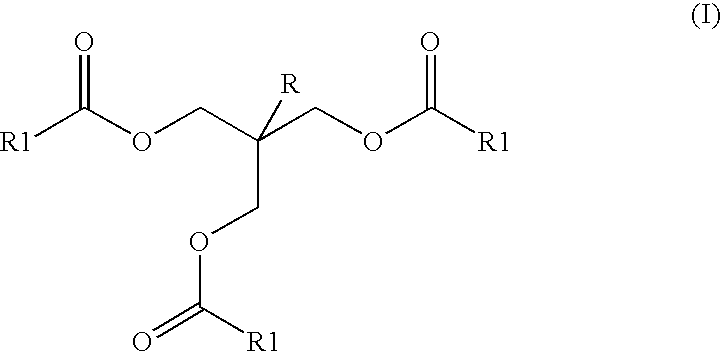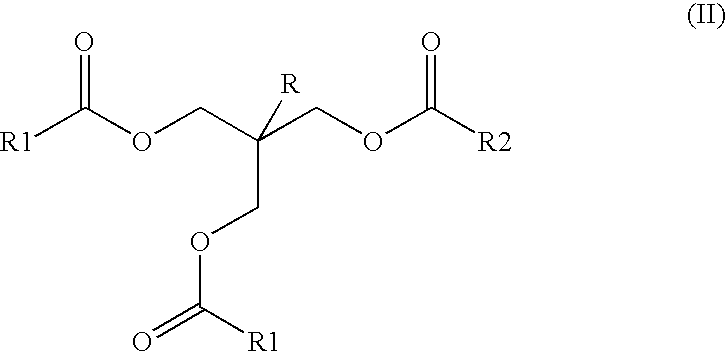Ester mixtures
a technology of ester mixtures and mixtures, applied in the field of ester mixtures, can solve the problems of insufficient compatibility of plasticizers with polymers to be plasticized, undesired, greasy film, undesired embrittlement of polymer formulations,
- Summary
- Abstract
- Description
- Claims
- Application Information
AI Technical Summary
Benefits of technology
Problems solved by technology
Method used
Image
Examples
Embodiment Construction
weight loss10.5%0.2%20.9%0.3%41.3%0.2%61.7%0.2%
[0105] The ester mixture in Example 2 features lower volatility than the standard plasticizer di(2-ethylhexyl) phthalate.
Polyvinyl Chloride Compounds
[0106] For further testing, the ester mixtures 1 to 4 and the additives listed in Table 4 were used to produce the soft polyvinyl chloride compounds of the epoxy / Zn type (with epoxy-zinc stabilizer) and Pb type (with lead stabilizer).
TABLE 4Composition of the polyvinyl chloride compoundsParts in epoxy / ZnParts in Pb typeConstituenttype compoundscompoundsPolyvinyl chloride100100(Vinnolit ® H70 DF)Plasticizer7070Stabilizer120(Crompton Mark ® EZ 735)1)Stabilizer08(Interstab ® LGH 6017)2)Calcium stearate11Chalk (Omya ® BSH)3)3030Antioxidant0.20.2(Ciba ® Irganox ® 1010)4)
1)Crompton Mark ® EZ 735 is an epoxy / Zn stabilizer.
2)Interstab ® LGH 6017 is a lead stabilizer from Akros Chemicals. According to the safety data sheet, it contains approx. 2% lead stearate (CAS No. 1072-35-1), approx. 6% d...
PUM
| Property | Measurement | Unit |
|---|---|---|
| Percent by mass | aaaaa | aaaaa |
| Temperature | aaaaa | aaaaa |
| Mass | aaaaa | aaaaa |
Abstract
Description
Claims
Application Information
 Login to View More
Login to View More - R&D
- Intellectual Property
- Life Sciences
- Materials
- Tech Scout
- Unparalleled Data Quality
- Higher Quality Content
- 60% Fewer Hallucinations
Browse by: Latest US Patents, China's latest patents, Technical Efficacy Thesaurus, Application Domain, Technology Topic, Popular Technical Reports.
© 2025 PatSnap. All rights reserved.Legal|Privacy policy|Modern Slavery Act Transparency Statement|Sitemap|About US| Contact US: help@patsnap.com



